SUNDAY, MAY 10, 2015
Offbook: A Ghost Light In-The-Round
By Wes Bedsworth
Operations Director
Hello OffBook readers! Fear not, Sarah will return next month. We're giving her one more month off since she's currently performing in Ernest in Love (come see it! it's adorable!) as Cecily... and possibly also because I felt guilty for strong-arming her into being our costume designer for the June production of Why Torture Is Wrong, and the People Who Love Them. She'll survive to blog another day, though. I wanted to take the opportunity in the blog to highlight one of the newer "features" in our building, which also brings in a bit of theater tradition: the Ghost Light. I apologize in advance, as I know I get a little technical at the end, but I know there are at least a few other nerds like me who will appreciate it! Here goes...
Many, if not most theaters have a tradition which involves leaving a dim light on in their performance space when it is vacant. This light is known by a few different names, Equity Light and Equity Lamp among them. However, a quick Google search or conversation with your favorite thespian (when they're not trying to lure you to their next show) would imply that this light is best known as the "Ghost Light." 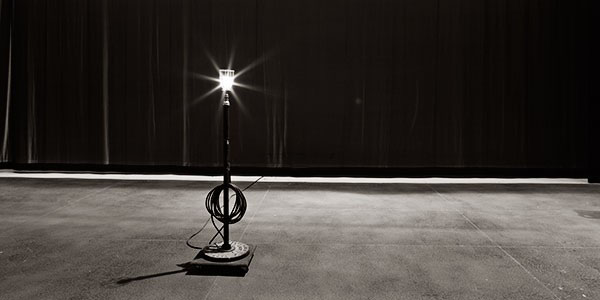 From what we can tell, the origin of the Ghost Light is hazy, at best, but most descriptions seem to take a similar form: a single exposed light in the form of gas, incandescent, CFL, or now even LED, housed in a small cage atop a moveable pedestal. The pedestal is generally placed somewhere near center stage, although this may vary by venue.
From what we can tell, the origin of the Ghost Light is hazy, at best, but most descriptions seem to take a similar form: a single exposed light in the form of gas, incandescent, CFL, or now even LED, housed in a small cage atop a moveable pedestal. The pedestal is generally placed somewhere near center stage, although this may vary by venue.
One particular explanation for the Ghost Light dates back to the 1800s when theatres were lit using gas-burning instruments before the electric lamp became widespread. Theaters had their own coal gas generators feeding a distribution system inside the venue that led to and controlled each lighting instrument. The Ghost Light was said to have been used to leave a flame going when all the lights were extinguished. This continuous flame supposedly prevented dangerous pressure from building in the gas lines, lowering the risk of a devastating explosion when the theatre was dark.
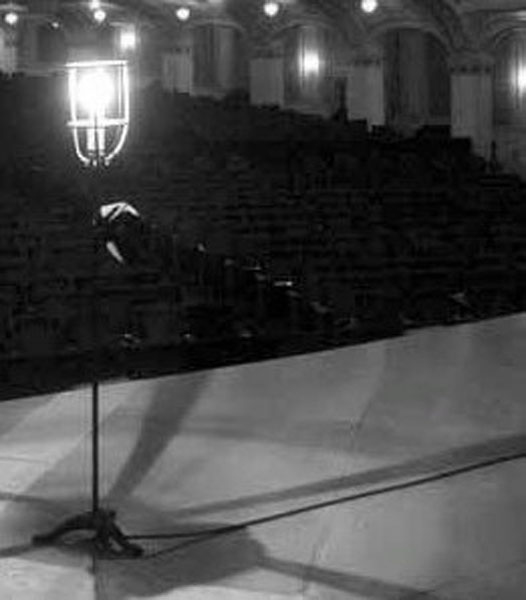 ...and what would something like a Ghost Light be if there weren't also some theatrical lore and superstition tied to it as well? It is believed by many that every theatre is haunted by at least one spirit, and that the Ghost Light is an essential component in keeping happy those spirits of thespians past. The light is said to allow them to perform on stage when the building is unoccupied without the dangers of "running into" the scenery (although one must wonder how a spirit would run into something when they are usually able to float through walls!). The Ghost Light also keeps evil spirits at bay, so the stories go, such that they do not interfere with ongoing productions. Phantom of the Opera, anyone? Beyond superstitions involving ghosts, there are also superstitions about a "dark" theatre. When a theatre is "dark", no production is currently running. It is believed by some that the Ghost Light ensures that a theatre is never truly "dark," thereby avoiding any associated bad luck.
...and what would something like a Ghost Light be if there weren't also some theatrical lore and superstition tied to it as well? It is believed by many that every theatre is haunted by at least one spirit, and that the Ghost Light is an essential component in keeping happy those spirits of thespians past. The light is said to allow them to perform on stage when the building is unoccupied without the dangers of "running into" the scenery (although one must wonder how a spirit would run into something when they are usually able to float through walls!). The Ghost Light also keeps evil spirits at bay, so the stories go, such that they do not interfere with ongoing productions. Phantom of the Opera, anyone? Beyond superstitions involving ghosts, there are also superstitions about a "dark" theatre. When a theatre is "dark", no production is currently running. It is believed by some that the Ghost Light ensures that a theatre is never truly "dark," thereby avoiding any associated bad luck.
Of course, regardless of whether it was part of the original driver behind the first Ghost Light, the practical explanation is that the light provides a level of safety for the living actors and staff who may find themselves in the building after hours. In a completely dark venue, it can be very easy for someone to trip over or walk into scenery, set pieces, or other obstacles; in a proscenium venue, there's an added danger of falling off of the stage into the orchestra pit. Having even the dim light of a Ghost Light enables one to see enough to avoid most dangers.
Enter Colonial Players theatre-in-the-round. In our unique space, taking a tumble off of the stage would require significant skill given that the stage is at the same level as the audience and we're lacking the orchestra pit found in many other venues. We do, however, have a few of our own concerns that are worthy of some kind of safety light, in addition to any fun superstitions we may want to attach to it.
If you've ever been in our performance space at night, or even during the day, and have had the lights turned off on you, you are already aware of how disoriented you can become. While we do have prominent EXIT signs posted at the two doors to the space, until your eyes adjust to the darkness, these really don't provide much help. After a minute or so, the EXIT signs cast enough dim light that you can almost make out the E1 and E3 exit ramps to get out of the space and try to find a light switch.
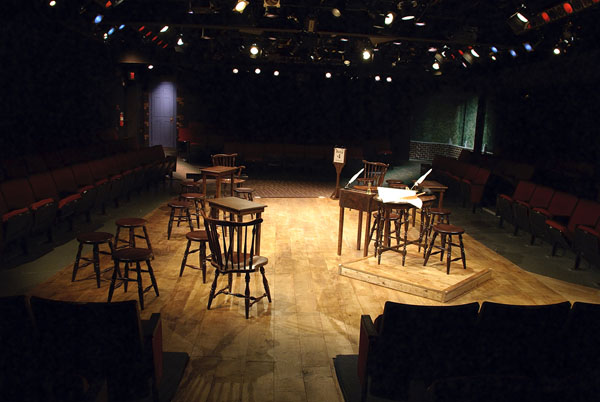 Stumbling around in the dark in our theater (or any!) is a risky proposition because of how often our sets, platforms, and alleys change to meet the demands of each particular production. Depending on the show, we have had anything from a couple small chairs on the stage (Hauptman) to a raised platform with a desk and chair, 18 stools, 3 Windsor chairs, a few tables, and a faux wall (1776), to a full house worth of furniture and very breakable props (Watch on the Rhine). One might also stumble upon (or over) a grand piano and other set pieces in E4 (In the Next Room), raised platforms dividing C Alley in half (Bat Boy), a complete waterfall system in C Alley (Wonder of the World), or even a drinking well in E2 (Cinderella Waltz) completely blocking the exit ramp. During construction weeks, things are even more chaotic because beyond all of the set pieces, there are tools, ladders, lighting instruments, tables, boxes, and various other items for one to trip over, run into, and/or impale oneself upon. And don't forget the techs and designers sleeping on the floor, trying to catch an hour or two of sleep between Dry Tech and Cue-to-Cue!
Stumbling around in the dark in our theater (or any!) is a risky proposition because of how often our sets, platforms, and alleys change to meet the demands of each particular production. Depending on the show, we have had anything from a couple small chairs on the stage (Hauptman) to a raised platform with a desk and chair, 18 stools, 3 Windsor chairs, a few tables, and a faux wall (1776), to a full house worth of furniture and very breakable props (Watch on the Rhine). One might also stumble upon (or over) a grand piano and other set pieces in E4 (In the Next Room), raised platforms dividing C Alley in half (Bat Boy), a complete waterfall system in C Alley (Wonder of the World), or even a drinking well in E2 (Cinderella Waltz) completely blocking the exit ramp. During construction weeks, things are even more chaotic because beyond all of the set pieces, there are tools, ladders, lighting instruments, tables, boxes, and various other items for one to trip over, run into, and/or impale oneself upon. And don't forget the techs and designers sleeping on the floor, trying to catch an hour or two of sleep between Dry Tech and Cue-to-Cue!
The obvious answer to make our performance space a little bit safer with the lights out was to find a way to implement a night light or sorts. What fun would that be if we didn't name it our very own Ghost Light in the process, though? The proposition was somewhat challenging given that we have so many different people coming and going every day that would need training on remembering to turn on and set out a Ghost Light. It doesn't do much good to have Ghost Light if it's not consistently turned on! How do we handle such a thing to make it easy and consistent, and so that we're not creating one more thing people have to remember to do when they leave? The answer: hang a Ghost Light from above so it doesn't have to be "set out," and then find a way to make it automatic so no one has to even think about it.
As background for those who aren't familiar, almost all of the general lighting in our building has been automated over the past few years, which means it can be centrally controlled by our building automation system. This system has made possible a number of helpful simplifications to our operation:
- Pre-programmed lighting scenes in the lobby which are activated by the "doorbell" buttons near the bar, making it simple for all ushers to quickly learn to control the lobby lighting. Previously, ushers had to manage 16 individual switches in four different locations to adjust front-of-house lighting; now it's just one button.
- Pre-programmed lighting "scenes" backstage activated by a set of backlit scene control buttons, allowing the Stage Manager one-button control of 20 individual switches backstage, plus two lobby lighting presets.
- Pre-programmed lighting scenes in the Theater activated by a set of backlit scene control buttons in the Booth, allowing the Show Technician one-button control of 8 switches for setting lights for pre-show setup, performance, and post-show cleanup, plus two lobby lighting presets.
- Automated lobby night lights, exterior lights, flagpole lighting, and marquee lighting that adjusts for Daylight Savings Time as well as sunrise/sunset without any intervention.
- Automatic shut off on all interior lights at certain hours of the night to prevent lights from being left on overnight by accident.
Given the flexibility of what lighting automation can achieve and has already achieved for us, we took a look at how this existing system might allow for a Ghost Light that our volunteers didn't have to worry about.
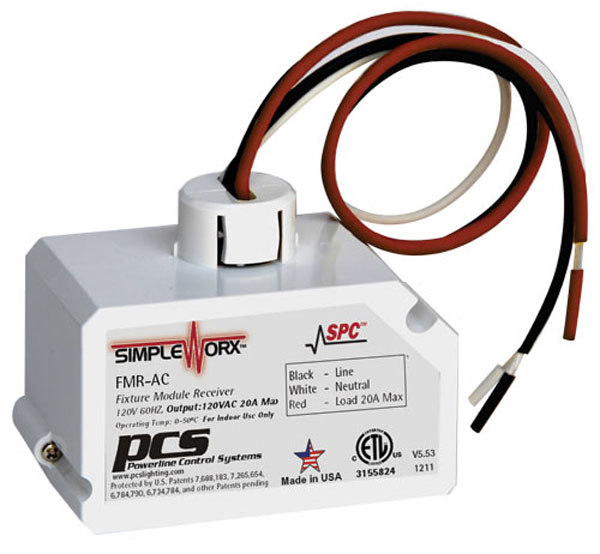 The line of automated switches we've deployed includes the option for a product called a Fixture Relay Module (FMR), which is essentially a remotely controllable component that can turn any connected device on or off. This is the product we picked for controlling our Ghost Light.
The line of automated switches we've deployed includes the option for a product called a Fixture Relay Module (FMR), which is essentially a remotely controllable component that can turn any connected device on or off. This is the product we picked for controlling our Ghost Light.
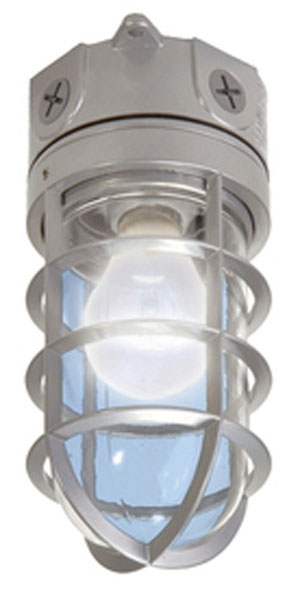 Next we needed an actual Ghost Light fixture to control. Given that it would be somewhat of a hassle for people to have to set out a traditional pedestal Ghost Light every time they leave, and it could be knocked over, and it would have to be stored somewhere in a building already tight on space, a ceiling-mount fixture like the one described earlier was the ideal choice for us. Looking at the available options at Home Depot and Maurice Electrical, the ceiling mount Vapor Light seemed like the best choice because it included a cage around the bulb which would protect it from being accidentally broken during a light hang event (plus it meets the "caged bulb" requirement of a traditional Ghost Light!). The Vapor Light is so named because it is suitable for wet environments, but that feature is irrelevant to our application... although if the roof leaks again...
Next we needed an actual Ghost Light fixture to control. Given that it would be somewhat of a hassle for people to have to set out a traditional pedestal Ghost Light every time they leave, and it could be knocked over, and it would have to be stored somewhere in a building already tight on space, a ceiling-mount fixture like the one described earlier was the ideal choice for us. Looking at the available options at Home Depot and Maurice Electrical, the ceiling mount Vapor Light seemed like the best choice because it included a cage around the bulb which would protect it from being accidentally broken during a light hang event (plus it meets the "caged bulb" requirement of a traditional Ghost Light!). The Vapor Light is so named because it is suitable for wet environments, but that feature is irrelevant to our application... although if the roof leaks again...
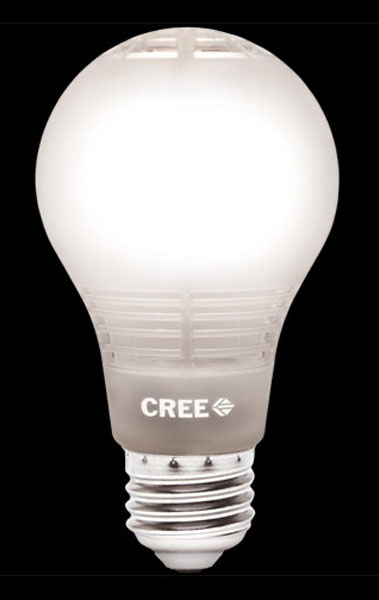 The recent popularity and price decline of consumer LED bulbs made these an obvious choice for illuminating our Ghost Light fixture. We needed something that would provide enough light to allow someone to see in the unlit space, while not wasting a lot of energy in the process. Cree offers a 6 Watt warm white LED bulb that is a 25 Watt equivalent. This was the perfect product for our project!
The recent popularity and price decline of consumer LED bulbs made these an obvious choice for illuminating our Ghost Light fixture. We needed something that would provide enough light to allow someone to see in the unlit space, while not wasting a lot of energy in the process. Cree offers a 6 Watt warm white LED bulb that is a 25 Watt equivalent. This was the perfect product for our project!
Installing the Ghost Light system was relatively straight forward. It was simply a matter of attaching the Vapor Light fixtures to the ceiling above the new light grid so that they were out of the way and unobtrusive, connecting them with Electrical Metallic Tubing (EMT conduit), and attaching the FMR controller mentioned earlier. We installed a total of four fixtures, one over each half of the stage, and one each in A and C Alleys. Power was already available in the ceiling by way of the existing Work Light circuit, so no new circuit had to be run from the Tech Booth.
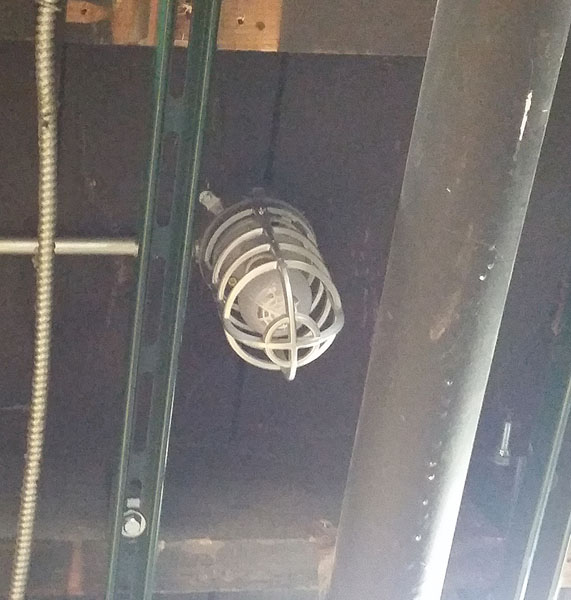 Now for the fun part: making it turn on and off automatically. At first glance, this seems straightforward. Anytime the Work Lights are off, the Ghost Light should be on, right? Yes, except when we have a performance. All of the lights need to be out in that case unless we want the Ghost Light to be a permanent part of the lighting designs. As part of the summer light grid and House Light renovation, we installed a lighting scene controller in the Tech Booth (mentioned earlier) that allows the Tech to quickly switch lighting scenes in the performance space. This controller allowed us to easily modify the lighting scenes to include the Ghost Light where appropriate (ON when all lights off, OFF during performance mode, and OFF when Work Lights are on).
Now for the fun part: making it turn on and off automatically. At first glance, this seems straightforward. Anytime the Work Lights are off, the Ghost Light should be on, right? Yes, except when we have a performance. All of the lights need to be out in that case unless we want the Ghost Light to be a permanent part of the lighting designs. As part of the summer light grid and House Light renovation, we installed a lighting scene controller in the Tech Booth (mentioned earlier) that allows the Tech to quickly switch lighting scenes in the performance space. This controller allowed us to easily modify the lighting scenes to include the Ghost Light where appropriate (ON when all lights off, OFF during performance mode, and OFF when Work Lights are on). 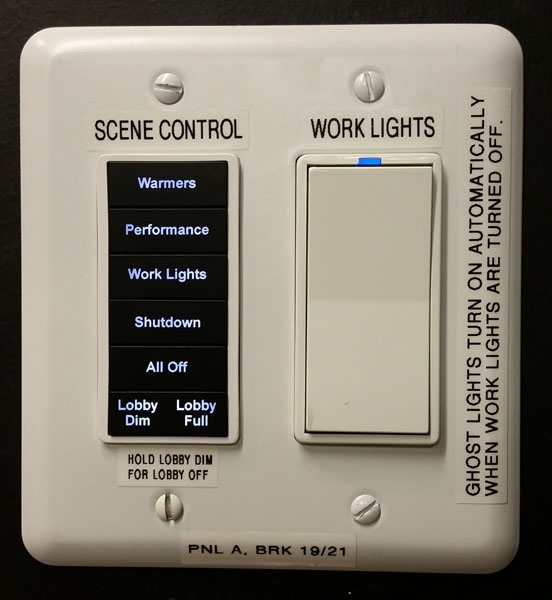 Beyond the lighting scene controller programming, we were able to program the dedicated Work Light switches to transmit ON/OFF commands to the Ghost Light when used (ON when Work Lights turned off, OFF when Work Lights turned on).
Beyond the lighting scene controller programming, we were able to program the dedicated Work Light switches to transmit ON/OFF commands to the Ghost Light when used (ON when Work Lights turned off, OFF when Work Lights turned on).
With a little bit of creativity, some simple conduit work, and some quick automation programming, we now have our very own Ghost Light that takes care of itself! Now when you come in the theater when it is unoccupied, a dim light will keep you from tripping over any surprise set pieces or other objects, and will help you find one of the light switches to turn on the Work Lights if you get stuck in the dark. Thanks to LED bulbs totaling 24W (6W x 4 bulbs), it costs us less than a nickel per day to run, too!
Now the question is: with the Ghost Lights in place, sufficiently lighting the stage, will spirits of actors past take it as an invitation to tread the boards at night when no one is around? Let us know if you're interested in spending the night on the stage to find out... I'm not! Either way, though, if you ever have the opportunity, check out the Ghost Light and let us know what you think!
For The Love Of It,
~Wes
References:
- http://en.wikipedia.org/wiki/Ghost_light_%28theatre%29
- http://dictionary.tdf.org/ghost-light-fina/
- http://seeksghosts.blogspot.com/2013/03/theatre-ghost-light-superstitions.html
- http://listverse.com/2010/08/20/top-10-theater-superstitions/
- http://www.broadwayspotted.com/ever-wondered-why/
- http://www.playbill.com/features/article/ask-playbill.com-the-ghost-light-153440
- http://en.wikipedia.org/wiki/Gas_lighting
- http://www.theatrecrafts.com/page.php?id=610

